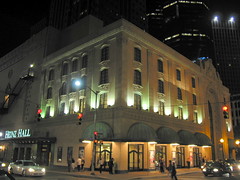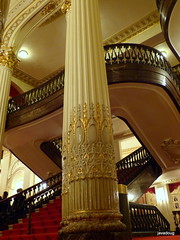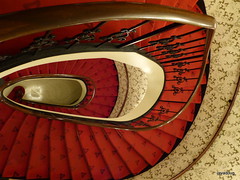 First I listened to several versions of the Sibelius 5. Then I went to the official website for the Finnish conductor Jukka-Pekka Saraste, Chief Conductor of the WDR Sinfonieorchester, and guest conductor for this evening's concert with the Pittsburgh Symphony Orchestra. I also watched a video of him conducting the Sibelius Symphony no. 5 with the Oslo Philharmonic on his own youtube channel. His version was by far better than all the other recordings. Perhaps it was the tempo, or the evenness of the sound, but It was much more appealing to my ears. So I knew I was in for a treat. As Rodrigo would say, he conducts with the blood.
First I listened to several versions of the Sibelius 5. Then I went to the official website for the Finnish conductor Jukka-Pekka Saraste, Chief Conductor of the WDR Sinfonieorchester, and guest conductor for this evening's concert with the Pittsburgh Symphony Orchestra. I also watched a video of him conducting the Sibelius Symphony no. 5 with the Oslo Philharmonic on his own youtube channel. His version was by far better than all the other recordings. Perhaps it was the tempo, or the evenness of the sound, but It was much more appealing to my ears. So I knew I was in for a treat. As Rodrigo would say, he conducts with the blood.
I also listened to Beethoven's 7th symphony in my car on my way to downtown Pittsburgh, a CD I had purchased only about a year ago, featuring Manfred Honeck conducting the Pittsburgh Symphony Orchestra. This way I could compare the PSO to themselves :).
But of course live music is always better than recorded, so it wouldn't be a fair comparison, except that I had seen and heard that performance at Heinz Hall a few years ago with all the microphones placed above and inside the stage. Tonight however, there were only 4 slim microphones, those used by WQED-FM to record the PSO for rebroadcast on their station. The winner was this recent performance, I believe the musicians were more relaxed because this performance wasn't going to be released on CD. Also a performance for CD might be changed in subtle ways to maximize it's sound on the CD, as opposed to making the sound better for the audience. But of course that's just my opinion.
In the lobby various musicians, dressed in black tuxedos, cordially introduced themselves to patrons entering Heinz Hall. Co-Principle Trumpet Charles Lirette was in the audience before the concert started. He was playing 'name that tune' for audience members with his trumpet. Heard were tunes like Flinstones and Raiders of the Lost Arc theme tunes. What was amazing was how softly he could play the trumpet compared to how loudly it is played during the performance, quite a dynamic volume range.
My seat was very close, I'd be able to hear all the intricacies of the music from each of the individual instruments.
 I'm usually way up above so the sound seems to come directly at me and it's not as easy to distinguish, but is more of an even sound. However being close this evening turned out to be quite interesting in that I hear, then see the sound coming from different instruments, I could almost pick out select musicians and hear just what they were playing. So, for instance, the second violin section and the violas would sometimes play a different line not at all like the melody portrayed by the first violins and the cellos. This was fascinating because it was quite new, I heard different parts I wouldn't hear on a CD or even way up in the gallery.
I'm usually way up above so the sound seems to come directly at me and it's not as easy to distinguish, but is more of an even sound. However being close this evening turned out to be quite interesting in that I hear, then see the sound coming from different instruments, I could almost pick out select musicians and hear just what they were playing. So, for instance, the second violin section and the violas would sometimes play a different line not at all like the melody portrayed by the first violins and the cellos. This was fascinating because it was quite new, I heard different parts I wouldn't hear on a CD or even way up in the gallery.
Jukka-Pekka Saraste, conducting the Oslo Philharmonic with Sibelius 5 was a wonderful performance, yet the live music with this conductor and the PSO beats it. It just doesn't seem like the same composition when heard live, it's multitudes better. The maestro maintained a nice tempo, but what was truly amazing was that he had no score, he must have know these two selections by heart. Of course without a stand to support the score, he had more room on the podium to move about.
With his conducting style I could feel compelled, as if I were a musician and needed to play, and even felt compunction for not contributing. His hand gestures, reaching out, necessitated and quietly urged participation. Hands and bow would move in unison, then separately, directing different sections at the same time. Then multi-tasking, the left hand embracing the cellos and his right keep tempo with his baton. His whole body became the baton, well balanced dancing multifaceted movement became the norm.
Stepping forward then back, waving, pivoting to face a section of instruments and coming to straight-backed attention to address the musicians was his particular blend of direction. Occasionally, with his left hand he would be 'playing' pretend piano, then waving, as if to bring in a section or augment a style, perhaps pizzicato. Then wildly moving like a tempest in a teapot (the podium), he would bring it home, the wildly exotic and inevitable transitions to the conclusion of a movement.
Comparing Beethoven's 7th of the CD to the live,
 I realized instantly that it is much better now in person. The strings remind me of a certain subtle sound that surrounds my listening, vibrations with meaning. The first movement glides with much alacrity and ends with three quick notes, foreshadowing the ending of the Sibelius 5 which ends with 5 quick notes. We move to the second, that intense but simple slow movement with a soul of feeling and plenty of pizzicato, goose bumps all around. In the third I relish the sustained violin. And just when you think its over, there is the final movement which gallops beyond the rest to the eventual ending. All the audience rises to applaud!
I realized instantly that it is much better now in person. The strings remind me of a certain subtle sound that surrounds my listening, vibrations with meaning. The first movement glides with much alacrity and ends with three quick notes, foreshadowing the ending of the Sibelius 5 which ends with 5 quick notes. We move to the second, that intense but simple slow movement with a soul of feeling and plenty of pizzicato, goose bumps all around. In the third I relish the sustained violin. And just when you think its over, there is the final movement which gallops beyond the rest to the eventual ending. All the audience rises to applaud!At then end of the evening conductor Saraste comes back on stage with a microphone to announce an encore. "It's a pleasure to be in Pittsburgh conducting this wonderful orchestra." He presents "Valse Triste" by Sibelius, and to that they play this wonderful short piece filled with sumptuous strings. On my way to the car, instead of the inventive notes of the Sibelius 5, I'm humming the melody of the Valse Triste.


No comments:
Post a Comment